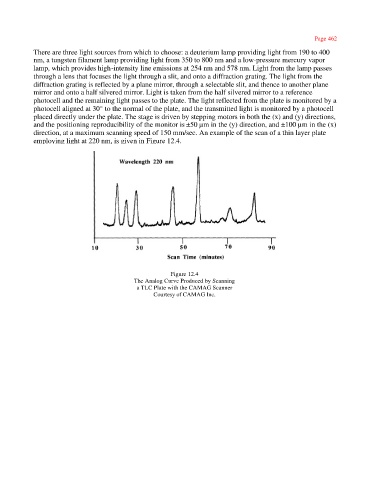Page 477 - Tandem Techniques
P. 477
Page 462
There are three light sources from which to choose: a deuterium lamp providing light from 190 to 400
nm, a tungsten filament lamp providing light from 350 to 800 nm and a low-pressure mercury vapor
lamp, which provides high-intensity line emissions at 254 nm and 578 nm. Light from the lamp passes
through a lens that focuses the light through a slit, and onto a diffraction grating. The light from the
diffraction grating is reflected by a plane mirror, through a selectable slit, and thence to another plane
mirror and onto a half silvered mirror. Light is taken from the half silvered mirror to a reference
photocell and the remaining light passes to the plate. The light reflected from the plate is monitored by a
photocell aligned at 30° to the normal of the plate, and the transmitted light is monitored by a photocell
placed directly under the plate. The stage is driven by stepping motors in both the (x) and (y) directions,
and the positioning reproducibility of the monitor is ±50 µm in the (y) direction, and ±100 µm in the (x)
direction, at a maximum scanning speed of 150 mm/sec. An example of the scan of a thin layer plate
employing light at 220 nm, is given in Figure 12.4.
Figure 12.4
The Analog Curve Produced by Scanning
a TLC Plate with the CAMAG Scanner
Courtesy of CAMAG Inc.

